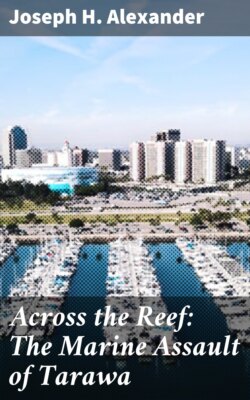Читать книгу Across the Reef: The Marine Assault of Tarawa - Joseph H. Alexander - Страница 7
На сайте Литреса книга снята с продажи.
Оглавление[Sidebar (page 3):]
The 2d Marine Division at Tarawa
Table of Contents
Major General Julian C. Smith’s utmost concern when he assumed command of the 2d Marine Division on 1 May 1943 was the physical condition of the troops. The division had redeployed to New Zealand from Guadalcanal with nearly 13,000 confirmed cases of malaria. Half the division would have to be replaced before the next campaign. The infantry regiments of the 2d Marine Division were the 2d, 6th, and 8th Marines; the artillery regiment was the 10th Marines; and the engineers, pioneers, and Naval Construction Battalion (“Seabees”) were consolidated into the 18th Marines. These were the principal commanders as the division began its intensified training program leading to Operation Galvanic:
CO, 2d Marines: Col William M. Marshall
CO,½: Maj Wood B. Kyle
CO, 2/2: LtCol Herbert R. Amey, Jr.
CO, 3/2: Maj John F. Schoettel
CO, 6th Marines: Col Maurice G. Holmes
CO,⅙: Maj William K. Jones
CO, 2/6: LtCol Raymond L. Murray
CO, 3/6: LtCol Kenneth F. McLeod
CO, 8th Marines: Col Elmer E. Hall
CO,⅛: Maj Lawrence C. Hays, Jr.
CO, 2/8: Maj Henry P. “Jim” Crowe
CO,⅜: Maj Robert H. Ruud
CO, 10th Marines: BGen Thomas E. Bourke
CO, 18th Marines: Col Cyril W. Martyr
Other officers who would emerge in key roles at Tarawa included Brigadier General Leo D. Hermle, Assistant Division Commander; Lieutenant Colonel Presley M. Rixey, commanding 1/10, a pack-howitzer battalion supporting the 2d Marines; Lieutenant Colonel Alexander B. Swenceski, commanding the composite 2d Tank Battalion; Major Henry C. Drewes, commanding 2d Amphibian Tractor Battalion; Major Michael P. Ryan, commanding Company L, 3/2; and First Lieutenant William D. Hawkins, commanding the Scout Sniper Platoon in the 2d Marines. Altogether, 18,088 Marines and sailors of the division participated in the assault on Tarawa Atoll. About 55 percent were combat veterans. Unlike Guadalcanal, the Marines at Tarawa carried modern infantry weapons, including Garand M-1 semi-automatic rifles, Browning automatic rifles, and portable flamethrowers. Assault Marines landed with a combat load consisting of knapsack, poncho, entrenching tool, bayonet, field rations, and gas masks (quickly discarded). Many of those carrying heavy weapons, ammunition, or radios drowned during the hectic debarkation from landing craft under fire at the reef’s edge.
Troops of the 2d Marine Division debark down cargo nets from a troop transport during amphibious training.
Department of Defense Photo (USMC) 63751
